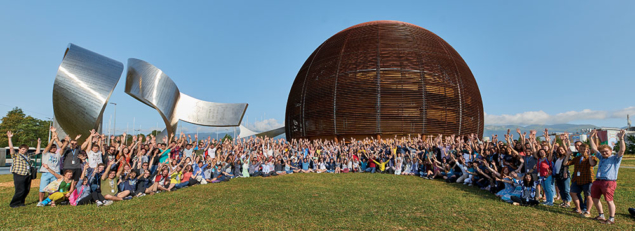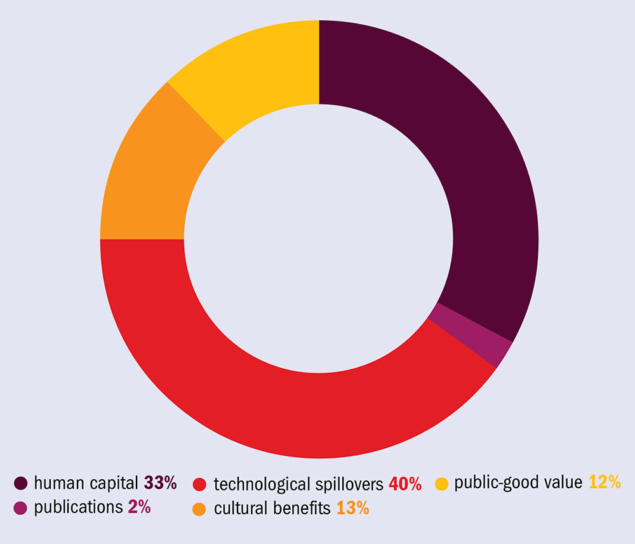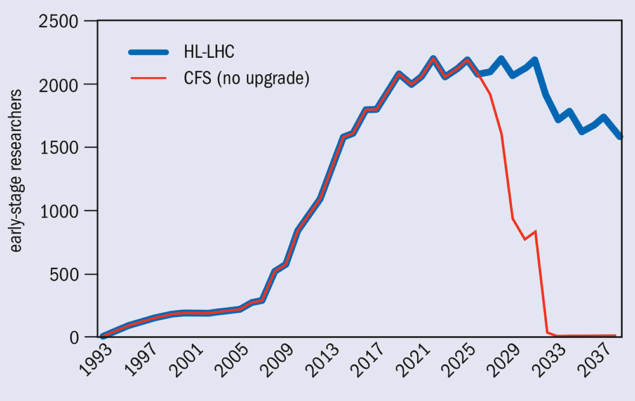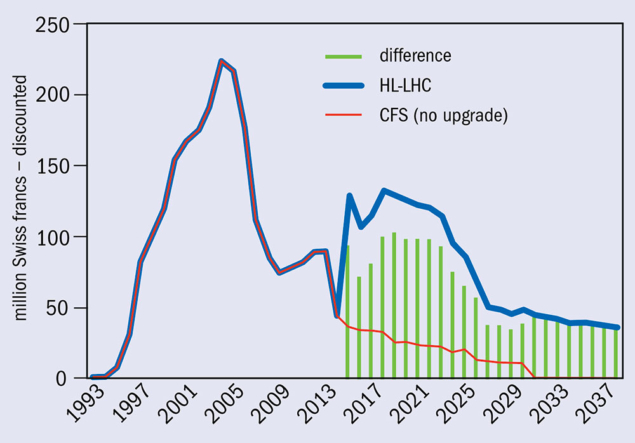A recent analysis of the cost and benefits of the high-luminosity LHC reveals a quantifiable return to society in terms of scientific, economic and cultural value.

CERN is a unique international research infrastructure whose societal impacts go well beyond advancing knowledge in high-energy physics. These do not just include technological spillovers and benefits to industry, or unique inventions such as the World Wide Web, but also the training of skilled individuals and wider cultural effects. The scale of modern particle-physics research is such that single projects, such as the Large Hadron Collider (LHC) at CERN, offer an opportunity to weigh up the returns on public investment in fundamental science.
Recently, the European Commission (EC) introduced requirements for large research infrastructures to estimate their socioeconomic impact. A quantitative estimate can be obtained via a social cost–benefit analysis (CBA), a well-established methodology in economics. Successfully passing a social CBA test is required for co-financing major projects with the European Regional Development Fund and the Cohesion Fund. The EC’s Horizon 2020 programme also specifically mentions that the preparatory phase of new projects that are members of the European Strategy Forum on Research Infrastructures (ESFRI) should include a social CBA.

Against this background, our team at the University of Milan in Italy was invited by CERN’s Future Circular Collider (FCC) study to carry out a social CBA of the high-luminosity LHC (HL-LHC) upgrade project, also preparing the ground for further analysis of larger, post-LHC projects. Involving three years of work and extending an initial study concerning the LHC carried out between 2014 and 2016, the report assesses the HL-LHC’s economic costs and benefits until 2038, once the machine has ceased operations. Here, we summarise the main findings of our analysis, which also includes the most comprehensive survey to date concerning the public’s willingness to pay for CERN investment projects.
Estimating value
Since the aim of the HL-LHC project is to extend the discovery potential of the LHC after 2025, it is also expected to prolong its impact on society. To evaluate such an effect, we require a CBA model that estimates the expected net present value (NPV) of a project at the end of a defined observation period. The NPV is calculated from the net flow of discounted benefits generated by the investment. Uncertainty surrounding the estimation of costs and benefits is tackled with Monte Carlo simulations based on probabilities attached to the variables underlying the analysis. For the HL-LHC, the relevant benefits were taken to be: the value of training for early-stage researchers; technological or industrial spillovers to industry; cultural effects for the public; academic publications for scientists; and the public-good value for citizens (figure 1). A research infrastructure passes the CBA test when, over time, the cumulated benefits exceed its costs for society, i.e. when the expected NPV is greater than zero. It is the methodology of a CBA not to account for scientific discoveries and results, since the aim of such studies is to quantify extra benefits that come from this type of investment.

Two scenarios were considered: a baseline scenario with the HL-LHC upgrade and a counterfactual scenario that includes the operation of the LHC until the end of its life without the upgrade. In both scenarios, the total costs include past and future expenditures attributed to the LHC accelerator complex and by the four main LHC experiment collaborations: ATLAS, CMS, LHCb and ALICE. The difference between the total cost (which includes capital and operational expenditures) in the two scenarios is about 2.9 billion Swiss francs.
HL-LHC benefits
For the HL-LHC, one of the most significant benefits, representing at least a third of the total, was the value of training for early-stage researchers (figure 2). It was shown that the 2038 cohort of early-stage researchers will enjoy a “salary premium” due to their experience at the HL-LHC or LHC until 2080, as confirmed by surveys of students, formers students and more than 330 team leaders.

The economic benefit from industrial spillovers, software and communication technologies is another major factor, together representing 40% of the project’s total benefits. Software and communication technology represents 24% of the total benefits in this category, while the rest comes from the additional profits for high-tech companies involved in the HL-LHC (figure 3). We looked at the value of hi-tech procurement contracts for the HL-LHC, drawing from three different empirical analyses: an econometric study of the company accounts in the long-term, before and after the first contract with CERN; a survey of more than 650 CERN suppliers; and 28 case studies. In the case of HL-LHC, incremental profits for firms represent 16% of the total benefits from sales to customers other than CERN, and this percentage increases to 29% if we consider the difference between HL-LHC and the counterfactual scenario of no HL-LHC upgrade.
CERN and society
Cultural effects, while uncertain because they depend on future announcements of discoveries and communication strategies, were estimated to contribute 13% to the total HL-LHC benefits. More than half of this comes from onsite visitors to CERN and its travelling exhibitions.
 Contributing just 2% of the total benefits in the HL-LHC scenario, scientific publications (relating to their quantity and citations, not their contents) represent the smallest overall socioeconomic benefit category. This is expected given the relatively small size of the high-energy physics community compared to other social groups.
Contributing just 2% of the total benefits in the HL-LHC scenario, scientific publications (relating to their quantity and citations, not their contents) represent the smallest overall socioeconomic benefit category. This is expected given the relatively small size of the high-energy physics community compared to other social groups.
The public-good value of HL-LHC, estimated to be 12% of the total, was inferred from a survey of taxpayers’ willingness to pay for a research infrastructure such as CERN. A first estimate was carried out in our assessment of the LHC benefits published in 2016, but recently we have refined this estimate based on an extensive survey in one of CERN’s two host states, France (see box). A similar survey is planned in CERN’s other host state, Switzerland.

Taking all this into account, including the uncertainties in critical variables and relying on Monte Carlo simulations to estimate the probabilities of costs, benefits and the NPV of the project, our analysis showed that the HL-LHC has a clear, quantifiable economic benefit for society (figure 4). Overall, the ratio between the incremental benefits and incremental costs of the HL-LHC with respect to the continued operation of the LHC under normal consolidation (i.e. without high-luminosity upgrade) is 1.8. This means that each Swiss franc invested in the HL-LHC upgrade project pays back approximately 1.8 Swiss francs in societal benefits, mainly stemming from the value of the skills acquired by students and postdocs, and from industrial spillovers. The study is also based on very conservative assumptions about the potential benefits.
What conclusions should CERN draw from this analysis? First, given that the benefits to early-stage researchers are the single most important societal benefit, CERN could invest more in activities facilitating the transition to the international job market. Similarly, cooperative relations with suppliers of technology and the development of innovative software, data storage, networking and computing solutions are strategic levers that CERN could use to boost its social benefits. Finally, cultural effects, especially those related to onsite visitors and social media, have great potential for generating societal benefits, hence outreach and
communication strategies are important.

There are also lessons regarding CERN’s investments in future particle accelerators. The HL-LHC project yields significant socio-economic value, well in excess of its costs and in addition to its scientific output. Extrapolating these results, it can be expected that future colliders at CERN, like those considered by the FCC study, would bring the same kind of social benefits, but on a bigger scale. Further research is needed on the socio-economic impact of new long-term investment scenarios.
Further reading
A Bastianin and M Florio 2018 CERN-ACC-2018-0014.
T Camporesi et al. 2017 Eur. J. Phys. 38 025703.
P Castelnovo et al. 2018 Research Policy (in press).
G Catalano et al. 2018 Journal of Economic Policy Reform (in press).
M Florio et al. 2016 Technological Forecasting and Social Change 112 38.
M Florio et al. 2018 Industrial and Corporate Change (in press).








